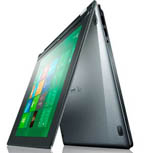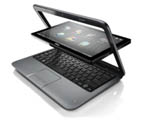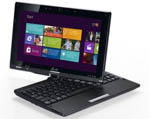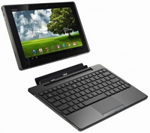Intel® Developer Zone offers tools and how-to information for cross-platform app development, platform and technology information, code samples, and peer expertise to help developers innovate and succeed. Join our communities for the Internet of Things, Android, Intel® RealSense™ Technology and Windows to download tools, access dev kits, share ideas with like-minded developers, and participate in hackathon’s, contests, roadshows, and local events.
Related articles:
Developer's Guide for Intel® Processor Graphics for 4th Generation Intel® Core™ Processors
Touch and Sensors
How to Create a Usable Touch UI
How to Adjust Controls for Touch
Introduction
Ultrabook™ 2 in 1s are PCs that can transition from laptop mode (for productivity needs) to tablet mode (for consumption needs). In this article, you can explore the hardware capabilities of 2 in 1 devices, opportunities that Windows* 8/8.1-based 2 in 1 devices provide to both consumer and enterprise applications, and recommendations for developing apps for the best user experience on each mode.
Scope
- Windows 8/8.1 Desktop Application Development
- 2 in 1 Device Classification (what is and is not a 2 in 1)
- 2 in 1 Usage Models
- 2 in 1-Mode Aware Applications
- Recommendations for Developing Applications for Ultrabooks
- Considerations for 2 in 1-Aware Application Readiness
What are Ultrabook™ 2 in 1s?
An Ultrabook 2 in 1 is a PC when you need it and a tablet when you want it. It has the same power and performance as a desktop PC or a traditional laptop, allowing you to perform all of the productivity and data creation tasks needed without compromising power or performance. Capabilities like touch and sensors and input devices like a stylus are also available on most 2 in 1 devices. And when users are on the go and want to do mobile (consumption) usages, like watch a movie, play games, check email, or read a book, they can switch to tablet mode, which is not only more convenient, but makes it unnecessary to have multiple devices. The extended battery life that is required on 2 in 1s adds even more value.
To be considered a true 2 in 1 device, the keyboard must be engineered for an integrated 2 in 1 design and must convert or detach into flat tablet usage. Devices with an aftermarket keyboard do not qualify as an Ultrabook 2 in 1. Additional criteria for Ultrabook 2 in 1s include a robust operating system like Windows 8/8.1 and a screen size of at least 10” or larger.
The following table shows some of the 2 in 1 device configurations currently available.
Table 1: Available Variations on 2 in 1 Device Configurations
| Form Factor
| Tablet Mode
| Laptop Mode
| Image of Model
|
| Folder
| 181⁰-360⁰
| 0⁰-180⁰
| 
|
| Ferris Wheel
| Screen facing outwards
| Screen facing the keyboard
| 
|
| Slider
| Screen covering any part of keyboard
| Screen not covering any part of keyboard
| 
|
| Swivel
| Closed lid position with screen facing up OR Stand mode with screen facing up.
| Any other positions
| 
|
| Detachable
| Screen detached from keyboard OR
keyboard attached with screen not facing the keyboard
| Attached with screen facing keyboard
| 
|
| Dual Screen
| Closed lid position with cover facing up
OR
Stand mode with cover / screen facing up
| Screen facing the keyboard
| 
|
What Isn’t an Ultrabook 2 in 1?
Just having a detachable display and keyboard doesn’t mean that a device can be classified as an Ultrabook 2 in 1. Below are some of the devices that are not included in the 2 in 1 classification:
- Touch-Enabled Laptops: While touch is a new feature on many laptops, it doesn’t meet the 2 in 1 definition because the device doesn’t convert from a laptop to a tablet and many aren’t lightweight or have other tablet-like capabilities.
- Android*/iOS*/Win RT Slate Tablets: These devices have an aftermarket keyboard that does not offer multi-tasking, application, and peripheral compatibility and thus cannot be classified as 2 in 1 devices.
- All in One Devices: While innovative and prominently used for gaming applications, these devices do not offer the capabilities of a laptop and tablet built into one device.
- Phablet: The form factor that intersects phone and tablet capabilities does not offer the same processing power, graphics capabilities, and battery life as 2 in 1 devices and thus cannot be classified as such.
Usage Model Examples
Now that you understand the device characteristics of 2 in 1 devices, let us explore some examples of the usage models that are supported on these devices. 2 in 1 devices change the paradigm for PC-based applications. In a world where we used to develop separate applications for productivity and consumption usages, 2 in 1s now provide a flexible platform to develop one application to meet both needs. The examples below illustrate some possibilities for consumer and enterprise applications on Ultrabook 2 in 1s.
Consumer Usages
- Multi-tasking versus single application usage: Laptop mode allows for multitasking between many applications, whereas multitasking is less likely in a tablet mode. Note, however, that this distinction is based on form factor usages in Windows 8 Desktop mode. Windows Modern UI applications have to adhere to the Windows 8 sandboxing guidelines.
- Games: Interactive games supporting keyboard/joysticks in laptop mode and touch-enabled overlay controls in tablet mode (Ex: GestureWorks* GamePlay)
- Data creation versus consumption: Including productivity and consumption usages in the same application requires additional design considerations.
Table 2 lists some of the usages for the two modes and shows differences and requirements for developing applications for 2 in 1 devices:
Table 2: Comparison of Laptop and Tablet Modes for Consumer Usage
| Laptop Mode
| Tablet Mode
|
| Browse and edit video and audio content (Ex: Magix Video*/Movie Edit Family* www.magix.com)
| Play video and audio content
|
| Make advanced edits using keyboard/mouse (Ex: Krita Gemini Application; www.kogmbh.com/download.html)
| Paint using touch/stylus
|
| Purchase a product
| Browse for products
|
| Type an email
| Browse email
|
| Use productivity applications to create documents or spreadsheets
| Browse documents or spreadsheets
|
| Add comments or type a response on social networking sites
| Browse a social networking site for updates
|
| Create documents using keyboard/mouse
| Read documents (using touch for navigation and stylus for taking notes)
|
Enterprise Usages
Using multiple devices to accomplish different tasks is common in many organizations. For example, a sales representative may use a laptop for detailed data analysis but carry a tablet to take notes during customer visits. 2 in 1 devices reduce the need to have multiple devices. The table below provides some examples of enterprise usages for Ultrabook 2 in 1s.
Table 3: Comparison of laptop and tablet modes for Enterprise Usage
| Category
| Laptop Mode
| Table
|
| Education
| Take notes in class, create study tools like flashcards, write papers, create presentations and copy and paste notes from multiple sources
| Consume data, like reading books and watching lectures while simultaneously taking notes with a stylus
|
| Health Care
| Enter chart notes using keyboard and mouse
| Enter chart notes using a stylus
Look up patient diagnostics using touch and stylus
|
| Retail
| Place orders, do in-depth sales or inventory analysis
| Search inventory for customers, help locate stock, even complete sales transactions on the show floor to reduce customer wait times
|
2 in 1-Aware Applications
Following are some examples for the type of experiences 2 in 1-aware applications could provide:
- Transformative UI: Applications that support a seamless change in UI to support the duality of 2 in 1 devices provide a good user experience. An application with a traditional PC-type UI while in laptop mode, but with a drastically touch-optimized UI in tablet mode is bound to provide a great UX. The UI switch can be automatic or manual as explained in the recommendations section below.
- Applications that provide a touch overlay on existing apps: This is suited for gaming applications that were designed for Windows* 7 and involved interactivity through a keyboard/joystick. While designing and developing for Windows 8, which is a touch-first OS, implementing an overlay with touch controls can provide a good user experience in both clamshell and slate modes.
Recommendations for Developing Applications for Ultrabook Devices
If you have existing apps on Windows 7 or Windows* XP, you may also want to consider the following development guidelines to help ensure a smooth transition when writing applications for the Ultrabook and 2 in 1 platforms.
Considerations for 2 in 1-Aware Application Readiness
The nature of how an application transitions from laptop mode to tablet mode is specific to each application. However, every 2 in 1-aware application must be able to: 1) detect state changes and 2) implement functionality to support the state change. Using the usage models and requirements for 2 in 1 awareness in the previous section as a reference, here are some recommendations to consider when developing applications for 2 in 1 devices.
- Detecting a state change: Table 1 listed some 2 in 1 devices and showed how they offer state changes in the hardware. Detecting state changes in the application, however, has some dependencies in the BIOS and firmware and is not supported on all devices in the market today. In preparing your application for 2 in 1 device-enabling, we encourage you to understand how to use the Windows 8 API to detect a state change from laptop to tablet and vice versa. More information on how to detect this change is provided in the articles below:
- Develop different UIs for laptop and tablet mode: The ways in which users interact with 2 in 1 devices in laptop and tablet modes differ significantly. While it is common to use a mouse and keyboard as primary input methods in laptop mode, touch and a stylus are preferred in tablet mode. A good consideration to enhance user experience would be to develop separate UIs for laptop and tablet modes.
- Write code to manually detect state changes: Since a device state change may not be automatically available, a good starting point may be to provide a manual switch within the application. This will ensure that your application requires less development efforts when the automatic state detection support becomes available.
- Provide touch-enabled game overlays for a great user experience: For PC games, adding a touch-enabled overlay control is an effective way of transforming the app to provide a good UX on 2 in 1 devices.
- Optimize the application to handle multiple inputs: Touch/stylus/keyboard and mouse provide effective fallback mechanisms where one or more inputs are not available. For example, not all 2 in 1 devices support a stylus. If your application uses functionality to use the stylus, include fallback mechanisms where these features work with touch on devices that do not support a stylus.
Summary
While Ultrabook devices are entering the mainstream market, 2 in 1 devices are a growing market segment. Application developers are encouraged to consider the opportunities and possibilities that these devices offer for application development, use the recommendations provided in this article, and prepare their applications for these devices, thereby reducing the effort and TTM to get their applications to the end user.
Intel, the Intel logo, and Ultrabook are trademarks of Intel Corporation in the U.S. and/or other countries.
Copyright © 2014 Intel Corporation. All rights reserved.
*Other names and brands may be claimed as the property of others.
